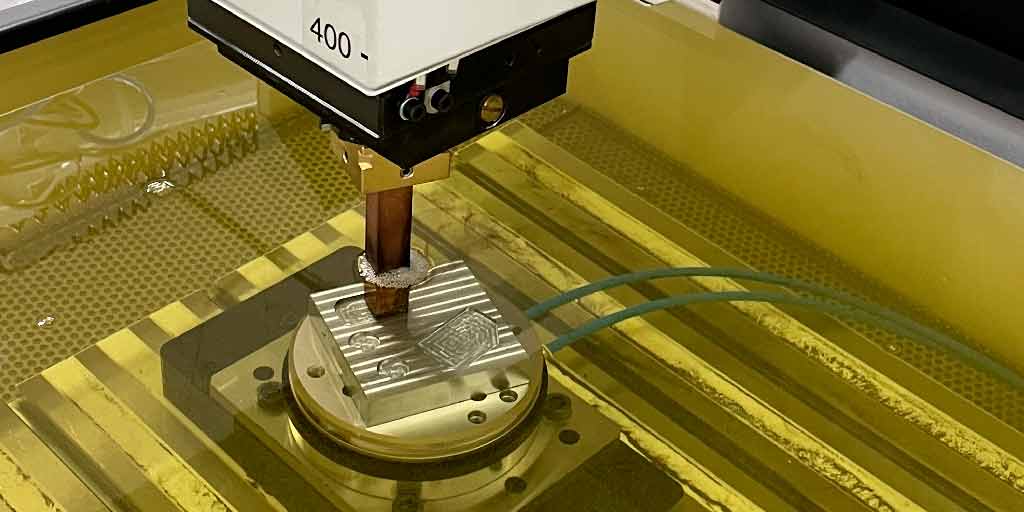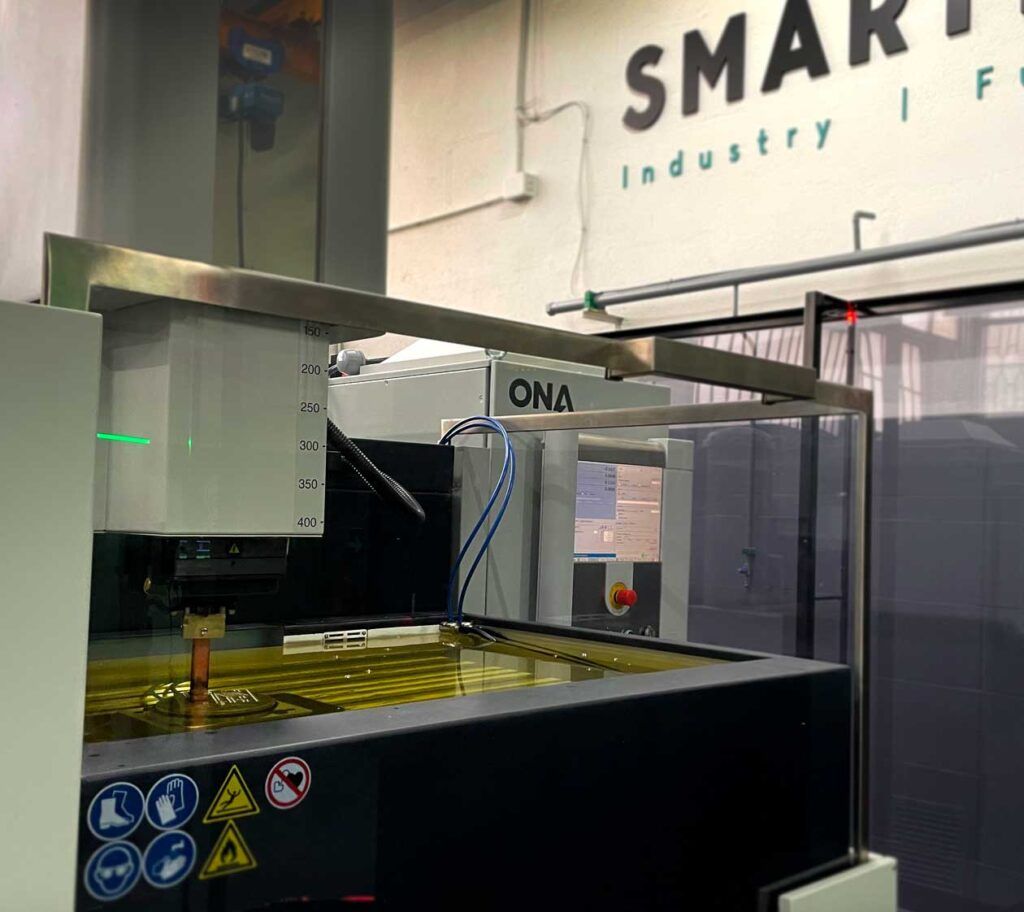Electrical discharge machining (EDM) is an established and, in some cases, irreplaceable process, although it does have some limitations in terms of productivity and quality.
The emergence of new developments related to automation are an opportunity to address these limitations, increasing process throughput and positioning it as a strong candidate when introducing automation on the shop floor.
If you want to know more about EDM, the benefits of automation and where to start to improve the productivity of your entire EDM process, keep reading.

A history lesson
The global market in which we live offers us the possibility of reaching new customers and markets, but also presents us with major challenges. Competition is also global and manufacturers from all over the world, including areas with much lower labour costs, are fighting to reach your customers.
In this context, technological innovation is the only way to position yourself ahead of other producers. It has been decades since many manufacturers realised the need to upgrade in order to remain competitive.
Incorporating a parts and electrodes loading system makes it easier for the machine to operate autonomously for more hours.
For example, speaking of the aforementioned EDM process, some manufacturers measured the running times of the machines on the shop floor and observed that it was only 15-20%. The rest of the time was spent on non-productive tasks, such as preparing parts and changing electrodes.
Increased machine uptime translates into higher productivity. Today, in this global context, machine uptimes below 50% are insufficient to remain competitive.How to solve it?
How to solve the low productivity of a manufacturing process?
(🤫 Spoiler: Commitment to the automation of manufacturing processes)
When thinking about process automation, some companies have mixed feelings. One of their main concerns is «How much will it cost? Is now the right time?», and although important, these should not be the only questions to consider when thinking about an innovation process. It will also be necessary to consider what this innovation will bring to the organisation, taking into account the short, medium and long term.
Here are some of the benefits and solutions that EDM automation can bring to your shop floor.
Benefits of EDM automation
1. Reduce lead times
EDM processes can easily be automated to become faster and more efficient. More complex tasks can be carried out with high quality finishes and using fewer electrodes, all thanks to automation and data analysis that reduces non-productive machine downtime, such as manual programming of the machine controller, set-up and start-up.
Furthermore, the system can automatically adapt to any possible incidents that may arise in the production process, thus ensuring the efficient management of the warehouse and the availability of production resources at all times.
2. Increase productivity
Automation can increase production hours by allowing the machine to operate for more hours without the attention of an operator, thus eliminating the human bottleneck. It will also guarantee the availability of electrodes at all times as they are managed in an integrated way with the rest of the processes.
3. Improve process repeatability
Once the process has been tested and automated it will offer high repeatability. This will mean a reduction in defective parts, reducing production costs while shortening lead time.

4. Reduce incidents due to human error
This repeatability also offers other advantages. Depending on the sector, it is sometimes difficult to find good workers who want to work weekends or shifts. Process automation, along with good data analysis helps to solve this problem, as it allows the results to be similar regardless of which operator is working.
It will also avoid human errors that introduce inefficiency into the process, such as misalignments, data entry issues, problems in manual programming of the machine controller, etc.
5. Free up operator time to invest in continuous improvement
Another important benefit of automation is the freeing up of operator time. Repetitive and low-value tasks will become automated, allowing people to devote their time, knowledge and experience to tasks that generate increased added value, such as optimising and improving processes.
6. Improve the quality of parts and electrodes manufactured
Thanks to better electrode management and a reduction in manual data entry, we can improve the quality of parts and electrode manufactured. The automatic data flow allows data to be captured for dimensional inspection of the parts and electrodes, reducing errors in dimensional inspections.
7. Increase flexibility in production
Another very important advantage obtained by automating this process is the increase in production flexibility, so that it can meet the demand for increasingly customised products (smaller batches with more product variety) and respond more quickly to possible incidents that occur in the EDM process, such as a change in manufacturing or the need for more electrodes than planned, for example.
In this other article we will talk more in-depth about the importance of flexibility in production systems.
Steps to improve EDM productivity
Increased throughput is achieved by increasing the machine’s uptime. This often means that new shifts have to be created, which is not always easy due to personnel costs or lack of manpower. Alternatively, the solution is to enable the machine to produce unattended, thus extending its productive time.
🚶♂️Kick-off | To enable the machine to operate autonomously for more hours, the first step is to incorporate a parts and electrodes loading system. This also requires the standardisation of all tools, tool holders and accessories, which will reduce set-up times.
🚶♂️🚶♂️The second step | The next «small yet major» step is to obtain a management system that integrates both the production process and the company’s other systems. By having the right data at the right time, better production decisions can be made, making the entire shop floor more flexible and dynamic.
👇 Key point | This point is key for all producers who want to automate their processes. Industry 4.0 is here and data management and analysis is a fundamental part without which it is impossible to incorporate new technologies.
The data obtained by integrating the company’s IT and OT systems enables the entire production process to be optimised by detecting and eliminating problems. Therefore, both the individual machines and cells and the shop floor as a whole can be configured to operate in the most efficient way.
🏃 Start increasing productivity | Once the system is in place to enable all of the above, improving productivity is relatively straightforward by increasing productive working hours (i.e. reducing non-productive machine time). Time may also be increased by double shifts or unattended production hours, such as weekends or evenings. This will reduce production costs and increase competitiveness compared with producers in other parts of the world.
👩💻 Measure the results | At this point, justification for investing in technologies that enable automation is easier to understand, even from a purely financial point of view, when the result is a two-fold increase in productive hours.
Nowadays, very affordable automation systems are available that can be integrated into the today’s reality on the shop floor and then extended to other production lines. In this way, it is possible to incorporate these automation processes progressively, avoiding the risk of making large investments and adding capacity in accordance with the company’s needs.
Do you need a partner to travel this path?
We hope that this article will give you a better understanding of the benefits of automating machining processes, such as EDM.
Improving through automation is now within the reach of any company. Although it is accessible, it requires the work of experts both in automation and in the actual manufacturing processes. At SMARTPM we know both worlds well, so if you need help or advice, do not hesitate to contact us.
